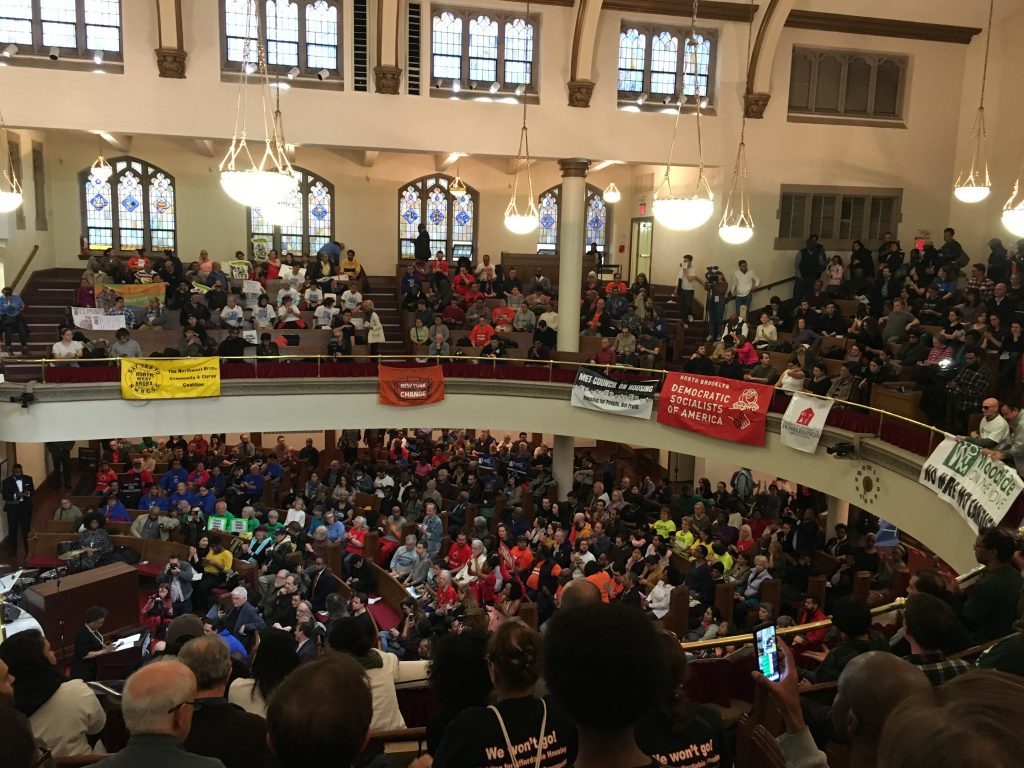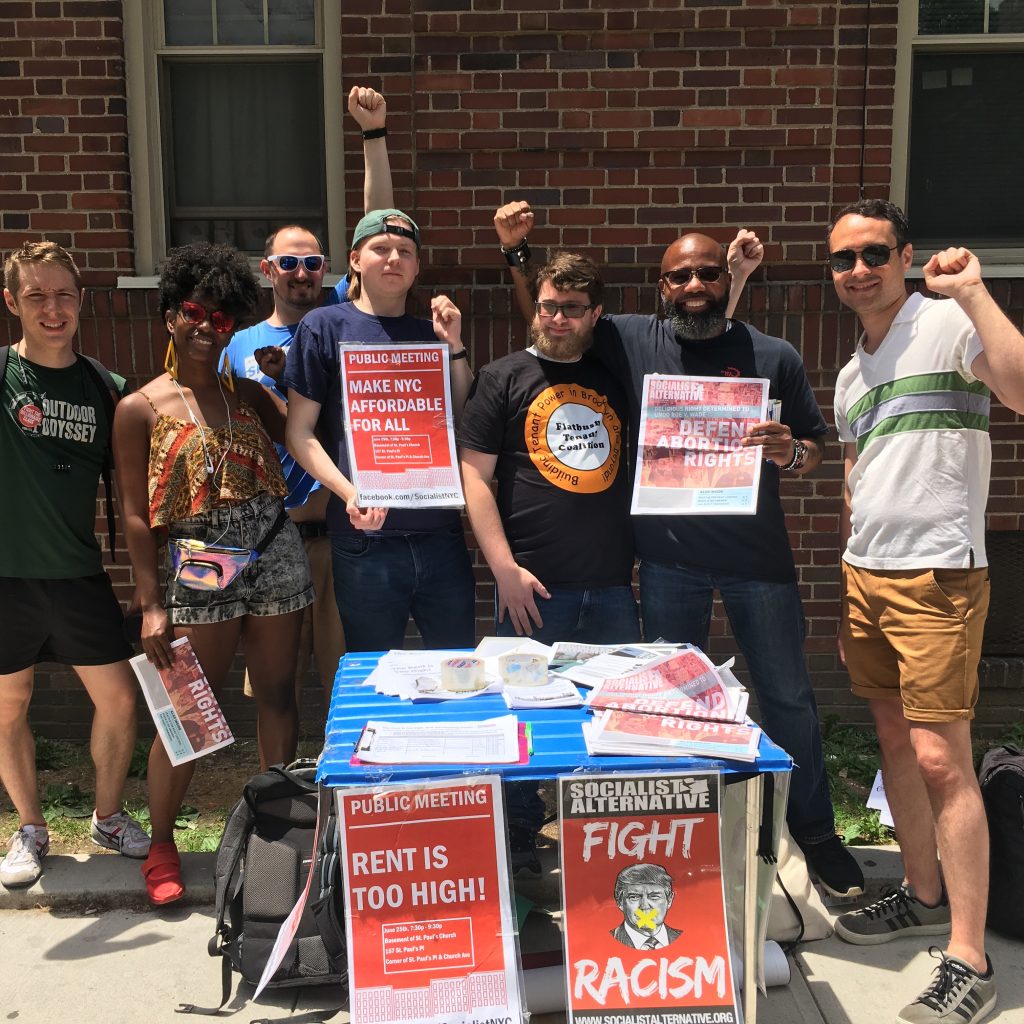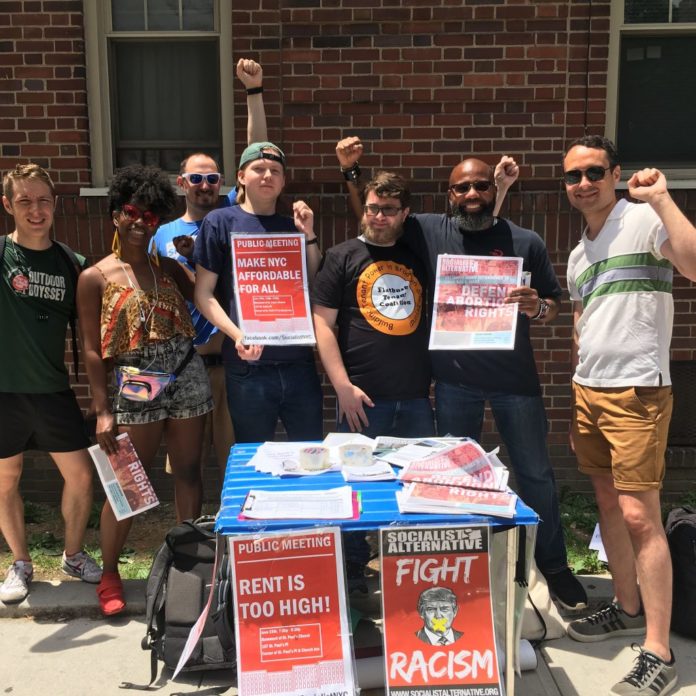The real estate lobby threatened to sue. Headlines in the mainstream press foretold mass disinvestment in rental properties. Landlords invoked the bad old days when the Bronx was burning and all but promised to stop repairing their buildings. But standing up and down the red stone stairways of the New York State Capitol, cheers and tears of joy drowned out all the naysayers. On June 14, fewer than six months after Amazon pulled out from its proposed sweetheart deal for a new headquarters in Long Island City, working-class tenants and activists won another stunning victory over New York’s all-powerful real estate industry.
Challenging the Agenda of Wall Street and the Real Estate Industry

United under the banner of Housing Justice for All (HJ4A), tenant organizations and progressive groups statewide won a raft of rent law reforms that will protect working-class renters in communities across New York State for years to come. The reforms close most of the rent regulation loopholes that have contributed to the loss of more than 300,000 rent-regulated apartments since 1994. The biggest win for tenants in New York City in more than a generation, these reforms are a vindication of the tireless efforts of the New York tenant movement over several decades.
The Housing Stability and Tenant Protection Act of 2019 (summarized in detail here) contained historic victories, although further steps are needed to solve the housing crisis. The new laws are permanent and no longer contain a “sunset” provision that forced renters to fight a rearguard defense every few years. Rent stabilization is opened up as an option to every county in a housing crisis — not just NYC and surrounding counties. Units can no longer be removed from stabilization because the rent exceeds $2,774, and landlords can’t raise rents by 20 percent when tenants vacate (this loophole frequently led to tenant harassment and unbearable conditions). The “preferential rent” loophole is closed, meaning eye-watering rent increases that have pushed tenants out of rapidly gentrifying areas are now illegal. And a range of new protections for renters are enshrined.
When We Organize, We Win!
This is a very important victory in the context of decades of displacement and predatory speculation that have changed the face of New York City and communities statewide. This win was the result of an unprecedented mobilization of tenants across New York State who joined together to cut across the false narrative, pedaled by the real estate lobby and its allies, that housing was just a “downstate” issue. Upstate tenants, lacking many of the protections of New York City renters and facing high rents, disinvestment, and predatory landlords, stood with downstate tenants to demand reforms that will now benefit millions of rental households. Tenants and working class people proved that landlords can be defeated, and that the pressure of organized movements can force change even when massively outmatched in finances and access within the halls of power.
So what didn’t tenants and working people get? Apart from watering down the reforms of long-abused “apartment improvement” loopholes (see full summary at end of article), state legislators and Governor Andrew Cuomo also failed to deliver on perhaps the most critical piece of the tenants’ platform — a right to prohibit eviction without “good cause.” This demand, the crux of HJ4A’s “universal rent control” platform, would have spread rent control to all renters in New York State, regardless of the size or age of a tenant’s building, by creating the right to a renewal lease with limited rent increases set by a local price index. Legislators also failed to deliver on the campaign’s demand for 20,000 additional units of supportive housing for homeless people — a crucial tool for moving people from shelter into permanent housing.
HJ4A showed the power of organized tenants not only by winning much of its platform, but by helping shape the political terrain on which it won. HJ4A and other progressive groups specifically targeted members of the Independent Democratic Caucus (IDC), Democratic members of the New York State Senate who formed their own block and caucused with Republicans to block progressive legislation like rent reform. With the pressure of these progressive groups, the IDC was obliterated in the “Blue Wave” of the 2018 election, and some progressive Democrats who publicly eschewed real estate donations, such as State Senators Julia Salazar (a member of the Democratic Socialists of America) and Zellnor Myrie, were ushered into power.
But when it comes to winning widespread housing justice — ending homelessness and providing well-built, permanent, affordable housing for all — the legislature’s failure on good cause evictions and the homelessness crisis show that working-class people still face an uphill battle. Rent-stabilized tenants, often with deep and long-standing neighborhood ties, have been central to New York’s tenant movement. With guaranteed renewal leases for tenants in good standing, rent-stabilized tenants can put demands on their landlords without fear of having their lease non-renewed. This makes organizing these tenants much easier than tenants with unregulated leases, and the tenants’ victory makes the importance of that organized power vitally clear.
Indeed, the power of rent-regulated tenant organizing is reflected in the content of the new rent laws, which close many pernicious loopholes affecting rent-regulated buildings, yet do little to bring unregulated tenants under the same protections. The Democratic-controlled legislature, controlled by Assembly Speaker Carl Heastie and Senate Majority Leader Andrea Stewart-Cousins, was forced by the movement to grant serious concessions, but pumped the brakes on expanding protections to the masses of unorganized, unregulated tenants who weren’t knocking down their doors demanding change.
Having won on many of the protections needed to protect rent stabilization, the New York tenant movement now finds itself facing critical strategic questions: How can we build a movement that moves beyond rent-stabilized tenants to demand rent regulation for all renters? And how would that movement take on the deep roots and shocking human impacts of this housing crisis, which go far beyond the rent laws themselves?
No Real Plan: The Establishment’s Failure on Homelessness and Affordable Housing
New York City faces a crisis that is unprecedented since the Great Depression. The number of people living in New York City homeless shelters reached a new high of 63,839 in January 2019 — an increase of more than 20,000 in just seven years. As for the New York City Housing Authority (NYCHA), about which Michaela Ciovacco of Socialist Alternative has written previously, its massive portfolio of aging buildings have been disinvested by successive mayoral and federal administrations to the extent that tens of thousands of tenants often lack heat and hot water. Most notoriously, more than 800 children in NYCHA apartments tested positive for lead poisoning between 2012 and 2016, and Mayor Bill de Blasio’s administration covered it up.
Meanwhile, the private rental market continues to squeeze working class people. Around half of all New Yorkers are considered rent burdened (paying more than 30% of their income in rent), with slightly more than half of those considered severely rent burdened (paying more than 50% of their income in rent). This instability has driven displacement and gentrification to the furthest parts of the Five Boroughs and called into question the very future of the working class people who really run New York City.
The response of Mayor de Blasio and the Democrat-controlled New York City Council to these issues showcases the limitations of relying on corporate politicians to do the right thing. Central to de Blasio’s housing plan has been a series of rezonings in low-income and working-class communities, such as Inwood, that will create a scant amount of “affordable” housing (often very unaffordable for most people living in these communities) in exchange for new market-rate “luxury” housing. These new affordable units are accessible mainly by means of housing lotteries, which put tens of thousands of people in consideration for a handful of affordable units. By bringing in new amenities and wealthier households, these developments raise property values and displace tenants and homeowners throughout the neighborhood. Corporate-financed politicians’ “solution” thereby ends up exacerbating the problem it was meant to fix, and does nothing to deliver deeply affordable, permanent housing for people with low or average incomes.
At both the city and state level, activists find themselves up against politicians who are not only funded by real estate dollars, but who serve as representatives of landlords and finance, rather than working people. In the 2018 election, with the rent laws looming, the Real Estate Board of New York, the foremost arm of New York’s development lobby, gave $237,000 to New York State Democrats — nearly four times what they spent the previous election cycle. Cuomo himself received hundreds of thousands of dollars in real estate donations in last year’s gubernatorial race alone. De Blasio and most members of the City Council have likewise taken donations from real estate. Progressives, including HJ4A, have succeeding in making refusal of these donations a litmus test — Council Speaker Corey Johnson has already said he won’t accept real estate cash during his mayoral run — but real estate still has deep pockets and strong ties, as evidenced by the runaway string of rezonings hitting every borough.
In the case of the rent laws, New York Democrats yielded reforms in response to public pressure in the midst of a crisis. But the working class must learn from our history and view these as the limited and temporary concessions that they are. Even the more decisive victories won under conditions of much stronger labor and tenant movements, such as rent control and public housing, have been diminished and undermined over many years. This year, even before the new rent laws were passed, the landlord lobby promised to sue to stop the new legislation from being implemented. And the Democratic legislature’s failure to deliver on good cause evictions and universal rent control is telling — these politicians will give concessions in order to defuse working-class revolts, but will not tinker with the fundamentals of the capitalist housing system.
We Need A Political Alternative — Socialism!

With the rent laws now permanent, the New York tenant movement and working class people can be proactive about building on the gains they have already secured. The movement must make sure that the state, particularly the Department of Homes and Community Renewal (HCR) has the funding, manpower, and political will to implement this year’s wins. But the fight must also expand, not only to end “apartment improvement” scams and win good cause eviction, but also to rebuild and expand NYCHA, and put an end to the city’s wasteful and cruel homeless shelter industrial complex.
It is critically important the labor movement now play a visible role in the tenant movement. Housing affordability affects union members and their families. Union members are themselves displaced and priced out by rising rents. Issues around housing and homelessness do not exist in a vacuum, but are the predictable effects of a capitalist system that prizes profit over human health, safety, and wellbeing. When the tenant movement has been most successful, it has been with the labor movement at its side, bringing the power of the organized working class to bear on politicians and fundamentally redefining the conversation around what working people deserve.
With a broad mass movement tied into a newly revitalized labor movement, tenants could fight for and finally win rent rollbacks for rent-stabilized tenants, and could begin to point toward the overall decommodification of housing: making housing a guarantee rather than an asset for wealth accumulation. The movement should also be prepared to take landlords at their word if they carry out their promised disinvestment from rental properties. If landlords are unwilling or unable to provide decent homes for people without the incentive of eye-watering profits, tenants should form their own committees to take over the running of these properties. In doing so, rents would be reduced, repairs would be made, and the profit motive would be removed.
The Housing Struggle Is International
These kinds of battles are not being fought only in New York, but in cities worldwide. In Seattle, the presence of Amazon and other tech firms has sent rents skyrocketing and created the largest homelessness crisis per capita anywhere in the country. Socialist Alternative member Kshama Sawant, who serves as a city council member in Seattle, has used her position to amplify the voices of working-class tenants and the housing justice movement. Housing activists in Seattle have used Kshama’s council seat to win an “anti-slumlord law” preventing landlords from increasing rents when their properties have outstanding code violations, and a cap on move-in fees; stopped proposed 400% rent hikes for low-income families in public housing; and saved a women’s shelter and other homeless services from being cut from the city’s budget, in addition to much more.
Furthermore, activists in Seattle successfully pushed the city council to create a tax on massive corporate employers in order to fund permanently affordable housing. But Amazon — the Goliath of Seattle politics — responded with a relentless fear campaign that ultimately led the Democratic-led council to reverse its decision, leaving Seattle tenants without a much-needed tax on the richest that would protect them from displacement and exploitation.
Yet the fight for affordable housing and rent control in Seattle rages on. Activists in Seattle, Vancouver, Minneapolis, and around the world, have taken up the call for universal rent control and made it a key demand of electoral campaigns. In Berlin, where tenants have watched one of Europe’s most affordable big cities be overrun by speculation and rising rents, activists have successfully called for a referendum on whether to expropriate thousands of apartments owned by landlords with portfolios of 3,000 or more apartments. The tenacity of Berlin tenants is such that their city government has already responded with a five-year rent freeze! But renters in Berlin should not be satisfied with this temporary concession and should keep putting forward bold demands that take housing out of the hands of speculators and into the hands of working class people who need it as a basic human right.
Here in New York, Socialist Alternative has stood with activists in the Justice for All coalition in Queens to keep Amazon out of NYC and to fight for better conditions in NYCHA housing. We have marched with tenants in the Flatbush Tenant Coalition to demand universal rent control and an end to gentrification and displacement in Brooklyn. And in the Bronx, we canvassed Assembly Speaker Heastie’s district with Met Council and the Democratic Socialists of America to pressure him to pass universal rent control.
New York needs housing for the 99%. Capitalism and the profit motive have dismantled affordable housing for the working class, poor, and oppressed. Although such housing has almost always been an afterthought in U.S. policy making, the 2008 housing crash made clear that the “American dream” as most people knew it was built on a bubble. Waves of foreclosures led to a six percent drop in homeownership, with most of those homeowners joining the more than 43 million American households who rent. The squeeze on this housing and relatively low levels of construction for new affordable units mean that more than half of all American renters are now rent burdened, paying at least 30 percent of their income in rent.
History shows that without a fightback, the capitalist class will be content to see this profitable situation persist indefinitely. That’s why working class tenants and the labor movement must build on the tremendous accomplishments of the rent laws to fight for high-quality, union-built, city-owned housing as a human right. Movements around the world show that significant gains can be wrested from capitalist politicians. Rent control, taxing big business to pay for high-quality affordable housing, and ending homelessness are vital reforms that can’t come soon enough. Alternative models of renting and ownership, including community land trusts and limited-equity co-ops, should be considered and applied where they are sustainable and democratic.
But to permanently end capitalism’s housing crisis, we must also begin imagining what a true socialist alternative would look like. Reforms like those above should point the way toward making housing a guarantee for all and make landlords obsolete. Only when housing is built, administered, and maintained by the communities who need it will we truly be able to guarantee stability and housing justice for all.


